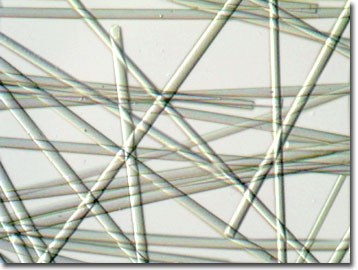Oblique Digital Image Gallery
Glass Wool
Glass wool, a synthetic mineral fiber, has found its way into domestic, commercial, and industrial buildings as a thermal and acoustic insulation product. Used in acoustic ceiling tiles, ducting for ventilation and air conditioning, and pipe insulation, public health questions pertaining to its suitability have raised red flags about potential cancer risks. Fine, airborne fibers may lodge in lung tissues and, like asbestos, may be responsible for deadly forms of lung cancer. Additionally, other respiratory symptoms such as asthma, chronic bronchitis, sore throat, hoarseness, coughing, and labored breathing are associated with exposure to glass wool without proper protective gear.

In the genetics laboratory, siliconized glass wool is utilized to isolate DNA in fragment purification methods. Manufactured from refined glass, glass wool is an amorphous silicate that may contain a binder and oil to help control annoying dust. Glass wools belong to a larger class of manmade vitreous fibers that are fabricated from minerals. They are used for insulation, building materials, air filters, and protective clothing. To produce glass wool, a spinning process based on centrifugal force is applied during the crown glass annealing process in a manner similar to making cotton candy. Molten glass is thrown out through holes by centrifugal force forming filaments, which are further extended into fine fibers by a high velocity blast of hot gas. After being sprayed with a bonding agent, the mat of tangled fibers is cured in an oven and then trimmed and guillotined into the desired sizes.
Originally developed as an alternative to asbestos for house insulation and woven into a fire-resistant cloth for curtains, glass wool is already being replaced. Derivatives such as glass microfibers and continuous glass filament are used in high tech applications such as high-performance filtration, aircraft insulation, and plastic reinforcement. Although many older aquarium hobbyists may believe they are still using glass wool as a water filtrant, most likely they are utilizing the commercially substituted synthetic spun "cotton" (nylon or polyester). This newer aquarium filtrant does not pose the airborne fiber risks and annoying skin irritations associated with handling spun glass wool.
Contributing Authors
Cynthia D. Kelly, Thomas J. Fellers and Michael W. Davidson - National High Magnetic Field Laboratory, 1800 East Paul Dirac Dr., The Florida State University, Tallahassee, Florida, 32310.
BACK TO THE OBLIQUE IMAGE GALLERY
BACK TO THE DIGITAL IMAGE GALLERIES
Questions or comments? Send us an email.
© 1995-2025 by Michael W. Davidson and The Florida State University. All Rights Reserved. No images, graphics, software, scripts, or applets may be reproduced or used in any manner without permission from the copyright holders. Use of this website means you agree to all of the Legal Terms and Conditions set forth by the owners.
This website is maintained by our
Graphics & Web Programming Team
in collaboration with Optical Microscopy at the
National High Magnetic Field Laboratory.
Last Modification Friday, Nov 13, 2015 at 01:19 PM
Access Count Since September 17, 2002: 16773
Visit the website of our partner in introductory microscopy education:
|
|
